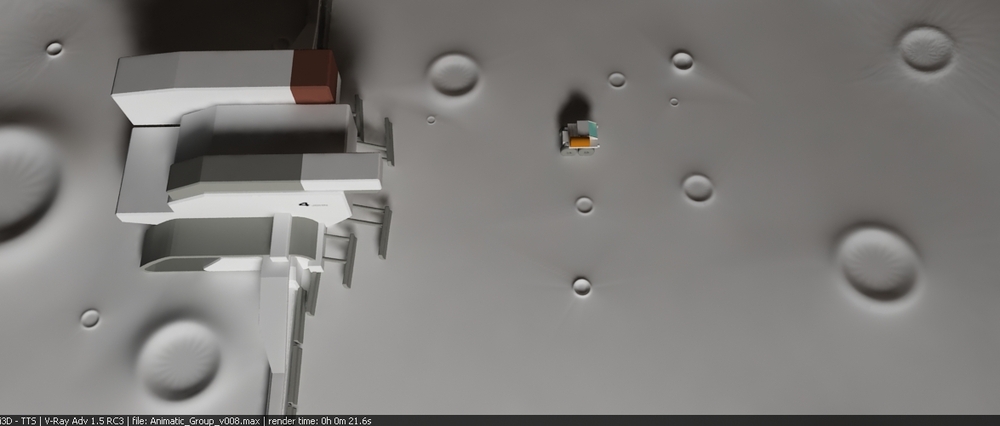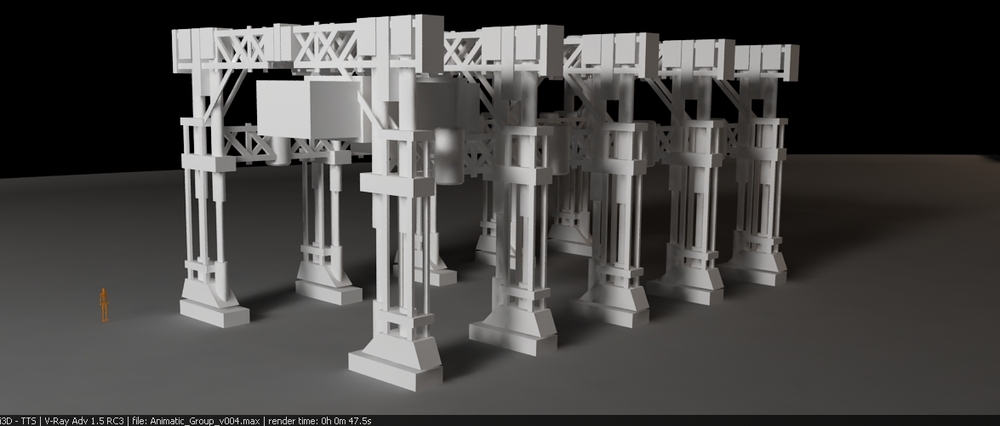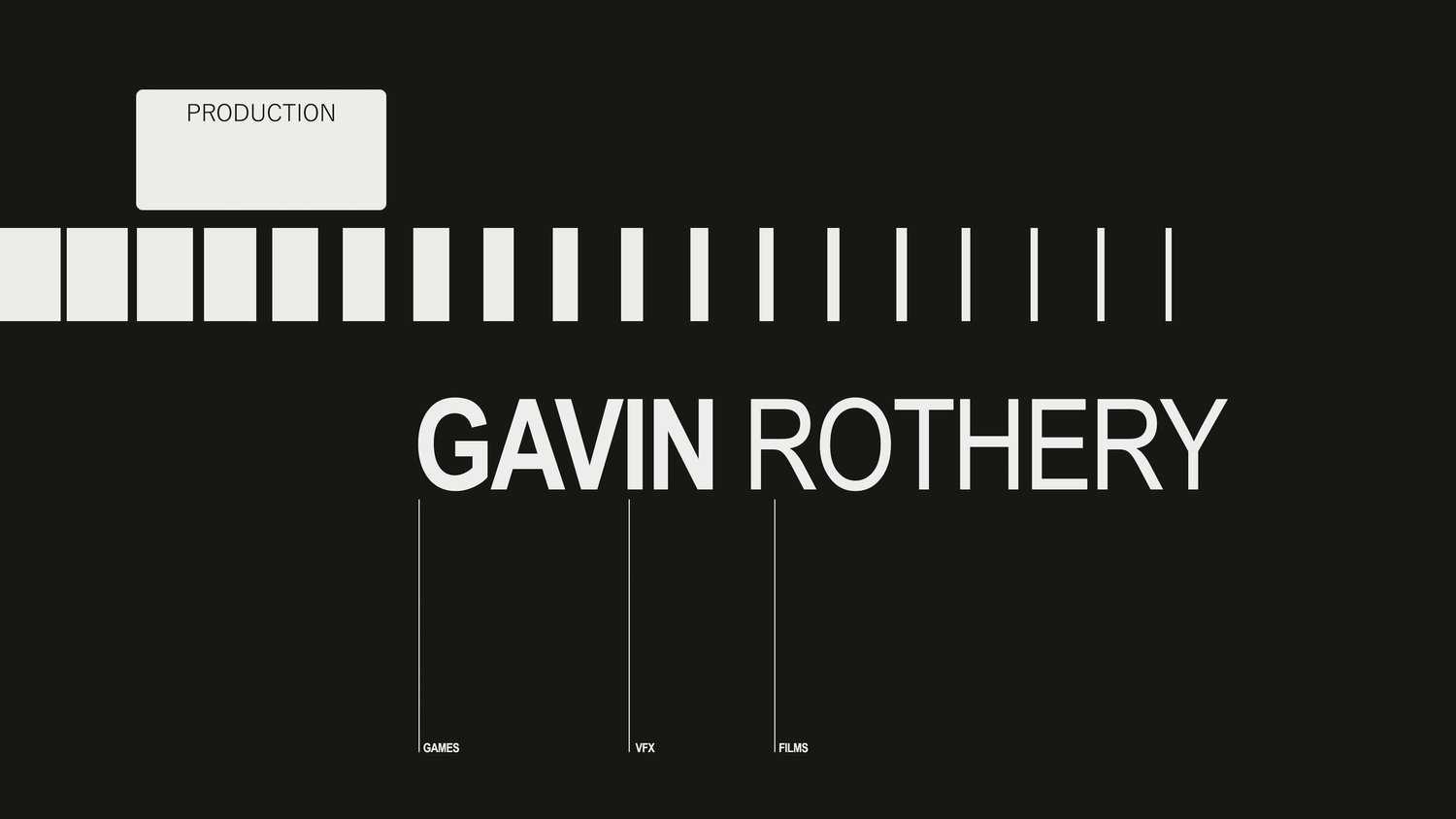As we didn't have much in the way of resources to prepare for the shoot, I ended up doing a lot of the prep work myself. As you are probably aware, storyboarding is an important part of the pre-shoot agenda. It can get be quite expensive and time consuming though as hiring additional artists for weeks on end can run up quite a tab. We were also locked into shooting dates as we only had the studio for a narrow window of time and so we had to proceed full steam ahead and just push problems out of the way as they popped up in front of us. We ended up getting three scenes storyboarded "traditionally" (with pens), which must have run to about two minutes or so of the anticipated length of the film. When you consider that the final cut runs to 97 minutes, that's a big hole we were staring into that currently existed only as words on a page. The rest of it was kind of hanging so I got nervous and jumped in and knocked up some CG assets so I could get a load of animatics together. An animatic is a motion graphics sequence (usually 3D) and is a rough version of the shot intended for the film, so essentially I was making rough versions of big sections of the film on my computer using rough placeholder graphics. I was primarily concerned with the VFX sequences as we had a lot going on. We had CG, miniature work and a lot of green-screen shooting coming up so I decided to forgo even more of my already minimal sleep in order to get our set up for the approaching VFX onslaught. You need to prepare for these things otherwise you will fail and this is not allowed to happen.
The animatic work was quite peaceful actually compared to the stresses of the rest of the shoot. I did most of this work in the evenings so I'd just get cosy in my bedroom with a cup of tea and some cake and bury myself in my little 3D Moon-world. Duncan would pop in and out and hang out a bit to check out what was going on whilst I was working and we'd just talk bollocks together whilst I boshed the shots out. I really enjoyed this as I got the assets together really quickly and then was into the animation and camera positioning and could concentrate on framing up the shots. I love playing with cameras in CG, it's so nice being in this little world and just hunting around with cameras playing with narative and composition and finding the shots. I'd say I could do it all night long but this turned out to be just as well really. The animatic work was ongoing even when we started shooting, and led through into a VFX animatic breakdown for the green-screen and miniature shoot. All these animatic scenes were being refined right up to the night before they were needed for shooting. I don't think a single aspect of this animatic work was done in daylight.

The image above is a still from a shot of the aftermath of the Rover-crash. Time constraints meant I had very little time to work up any of these assets so they are very rudimentary but they're enough to get the idea across. This is why all the vehicles have clearly visible numbers on them. We did a lot of that in Moon, on any specific piece I'd do just enough work on it to make sure I got the point across and then move swiftly on.

Here's something you'll never see anywhere else; four harvesters mining a patch of lunar regolith especially rich in Helium 3. This was me just trying things out really and was never anything we were going to shoot. I just like seeing lots of the same vehicle together; I always think it just looks cool. I do think this would have been a lovely shot if it had come about for whatever reason, imagine how it would look with the four harvesters chucking all their muck out and emerging with their lights cutting through the dust cloud.

This is an initial model I did of the Eliza rig with a humanoid in there for scale. I was pretty chuffed that in the end of the film I was the Eliza captain and came up on the crew manifest. As the time it was just us mucking about but now it's all finished it's a fun little story and I can always tell girls in bars that I have my own ship in a sci-fi film making me a legit badass space murderer. To be honest it's the closest I’ve got so far to being Han Solo and that’s good enough for me. Actually I could get a puppy sidekick and try to teach him to drive my car...

I mentioned previously that the Eliza support rig was intended to support the harvesters and could transport them around. Here we see a harvester to scale underneath the rig. The harvester booms collapse back along the side of the harvester, I think this might be visible in the film actually where you see the dead harvester "Judas" (Formerly "Luke"-no Star Wars reference) being worked on remotely outside the Sarang Facility garage. I read about a chap who had this conspiracy theory who "worked out" the harvester mileage numbers when Sam reads them out from the start of the film as bible references. He has this theory that there is a DaVinci code type of thing going on with the harvesters and quoted the bible passages as a comment of mans' destruction of the environment in pursuit of energy resources. Excellent work dude, you are bang wrong. I had an idea of how fast the harvesters were going to move on-screen and it ended up about three miles an hour. I actually had in mind them moving slower than this and covering about ten miles or so a day but we had to speed them up a bit for the rover docking sequence so they looked right. So I'm saying they generally do about half a mile an hour but speed up a bit when Sam’s' picking up a container as they're less likely to stall at higher speed. A stall with a docked Rover and personnel on board whilst transferring pressurised fuel cylinders would be bad as the actual stall event would be quite violent.

I tried out a few helicopter-type shots like this but in the end decided to go with realistic camera angles. I find that whenever you're putting together shots like this you always get a more believable end result it you try and put the camera somewhere it could actually be if you were using real kit and the shot was full-size. You'll see that most of the external lunar-landscape shots in Moon are done from realistic cameras and are usually from the equivalent of head-height or perhaps up on a gib arm. There are a couple of exceptions to this but mostly we had the camera right down on the table which made keeping the foreground crispy sharp in-focus really tricky. You have to be careful when you're doing work like this as positioning the camera is a huge responsibility. These animatics became the shooting template for everything that involved the DMP work (Digital matte painting), lunar exteriors, all vehicle shots, rover interiors and anything with a suited-up astronaut in it. Altogether that added up to around 22 minutes of the original shooting script. I remember some of these late night being really cozy as I was working away in my bedroom and everybody else was asleep. It was winter as we were doing this and it was really cold outside. I was tucked up all nice and warm making my little space-film on my computer smashing my little moon vehicles into each other like a little kid. I remember when I was four I had to write a letter to Santa at school asking what I wanted for Christmas. I asked for a spaceship and a robot. I remember my excellent Dad got me Luke’s X-Wing from the original Star Wars toy line and C3PO and R2D2 figures.
